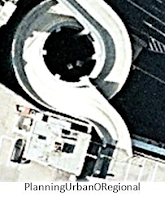Traditional
planning approach and values - being lost in transition?
Any random street corner
of any random city, corner at the junction of streets, streets busy or calm, chaotic
at times, still having its own order, order in transition, transition of daily commuters,
transition of shifting daylight, transition of shadows, glitter of street and
neon signage light, LED shop window and synchronized traffic light, that flux
of casual traffic light, that changing activity landscape across the day across
the seasons with occasional pause. But peculiar are the streets of old and heritage
cities, cities with history, those streets and corners evolved from the
centuries of planning and urban design experience, tailor-made to the local
needs of community and neighborhood, with varying characteristics across the
region across the city and across the world. Wisely adapted for local climate,
some designed for extreme harsh summer, some for tons of snow, an ancestral
legacy of planning and design up-to the last fine details of drain cover and
cast iron light-pillars and articulated bollards.
Though respected, preserved
and encouraged in some cities, that example and inherited legacy of urban
design and planning is fast deteriorating and disappearing, sometimes out of
ignorance sometimes purposefully ignored, in several parts of the world and
almost in any upcoming new city in any corner of world, that local wisdom of
traditional planning is increasingly being lost and being mechanized, being templatified.
Traditionally those streets and corners were designed to protects commuters from
harsh sun, from icy wind, and from pouring rain and sudden snow, those
meandering streets used to have a texture of character with those spaces to
pause and relax and in the comfortable safe niches, a place to chat and
socialize and a place to engage oneself in that active buzz of street, corners
reinforced to give it a distinct recognizable character. That legacy of
traditional localized planning is calling for justice and revival.
Thinking about fabric ofcity especially within city boundaries, a natural question comes to mind, why a
vast country with extremely diversified heritage and climatic regions and special
needs should have only few standard templates of streets sections and junctions
and street corners with little bit possibility of urban design integration
mostly for sake of localization formalities? Templates though give advantage of
planning execution, better control and cost efficiency; it tends to encourage deterioration
of heritage characters and inherited values and learning mostly in the name of
infrastructure and technical feasibility, commercial viability, changing
lifestyle requirements, uniformity, standardization, international acceptance
etc. Of-course needs are different today, speedy transport, higher population
density, quantum shift in lifestyle and technology, higher latent demand, etc.,
hence the different planning approach visible and practiced today, but we
should ask ourselves, can we incorporate those learning experience from our
past generations into today’s planning process and can we infuse them in today’s
“easy way out templates”? With all the technological advancement and possibilities
and centuries of learning experience, one thinks that it’s somewhat possible to
strike the balance between traditional learning and present planning approach
preserving the character and dignity of that specific city that specific core
and that neighborhood, starting right from the careful planning of that street
and that street corner. All it needs is a tender heart, logical brain and collective
will of planners, urban designers and policy makers and may be few extra bucks!


































